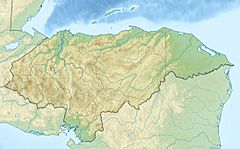Craugastor chrysozetetes facts for kids
Quick facts for kids Craugastor chrysozetetes |
|
|---|---|
| Conservation status | |
| Scientific classification | |
| Synonyms | |
|
Eleutherodactylus chrysozetetes McCranie, Savage, and Wilson, 1989 |
The Craugastor chrysozetetes, also known as McCranie's robber frog, is a type of frog that might be possibly extinct. It belongs to the family Craugastoridae. This frog is special because it was only found in one place: Honduras. Specifically, it lived near a mountain called Cerro Búfalo, which is close to the Pico Bonito National Park.
Contents
What Does This Frog Look Like?
Adult male frogs were about 34 to 41 millimeters long from their snout (nose) to their vent (tail end). Adult females were a bit bigger, measuring 37 to 46 millimeters.
Their snout was rounded when you looked down from above. From the side, it was also rounded. These frogs did not have a visible eardrum (called a tympanum). However, they had a clear fold of skin above where the eardrum would be.
Their fingers had special ridges along the sides and wide, flat tips, but they were not webbed. Their toes also had wide, flat tips and were webbed. The parts of their toes that were not webbed had fleshy fringes.
The skin of these frogs was often wrinkled and had many small bumps, called tubercles. The top of their body was dark olive-brown with lighter olive-brown patches. Some females were mottled with olive-green and dark olive-green. The underside of their body and throat was a pale purple color. Some had dull white spots on their chin and pale blue spots on their chest.
Where Did This Frog Live?
The McCranie's robber frog lived in wet forests on mountainsides. These forests were found at elevations between 880 and 1130 meters above sea level. They were specifically found along a stream called Quebrada de Oro.
Why Is This Frog in Danger?
This frog was always rare, meaning there were not many of them to begin with. Scientists visited its only known home several times but could not find any frogs. Because of this, in 2004, the International Union for Conservation of Nature (IUCN) said it was extinct.
The main reasons for its disappearance are thought to be habitat loss and changes to its environment. This includes:
- Deforestation: Trees being cut down.
- Farms expanding into its habitat.
- More people moving into the area.
- Logging (cutting down trees for wood).
- Fires.
- Landslides.
A disease called Chytridiomycosis (a fungal infection that affects amphibians) might have also played a role.
However, in 2019, the IUCN changed its status. Now, the frog is listed as Critically Endangered (Possibly Extinct). This means there is a small chance it might still be alive, possibly hiding within the Pico Bonito National Park.
See also
 In Spanish: Craugastor chrysozetetes para niños
In Spanish: Craugastor chrysozetetes para niños



